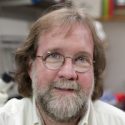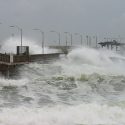Preparing for better weather forecasts

Hung-Lung (Allen) Huang, DIS scientist with the Space Science and Engineering Center, poses outside his office at the Atmospheric, Oceanic and Space Sciences Building. Huang recently was the first scientist in the Graduate School to receive the title “distinguished scientist.”
Photo: Aaron Mayes
Rain or shine, hurricane or thunderstorm, inaccurate weather forecasts can leave you drenched when the forecast called for sun or trapped in a house as a storm gathers more force than expected. Tomorrow’s forecast depends partly on measurements from instruments aboard satellites orbiting a few hundred to tens of thousands of miles above the Earth. During the next two decades, the amount of information from these satellites will increase dramatically, leading to more accurate weather prediction but requiring more effort to understand.
UW–Madison scientist Allen Huang is at the forefront of preparations for new satellite instruments and the predicted data deluge. Huang’s contributions will improve severe weather forecasts and environmental monitoring and lead to a better understanding of the Earth’s changing climate.
Measurements of the Earth from space have many applications, says Huang. “Some people use the data to detect fires, some use it for agricultural management, some use it for aviation, some use it for forecasting.”
Huang leads several teams of research scientists, software programmers and engineers in efforts to help “maximize the potential of the instruments we put into space.” He also travels around the world readying the next generation of scientists.
Huang’s enthusiasm for using satellite data to learn about the Earth inspired him to organize seminars around the world with the help of his colleagues at UW–Madison’s Cooperative Institute for Meteorological Satellite Studies (CIMSS). At a recent seminar in South Africa, Huang spoke of his journey from Taiwan to Wisconsin, from meager beginnings to a reputation as an internationally respected atmospheric scientist. “His message to the students was that ‘this could be you too,’” says Kathy Strabala, a co-worker of Huang’s and an instructor at the remote sensing seminars.
Seminar participants learn how to use a software package developed by one of Huang’s research teams and how to tailor it for regional use. The software package manages satellite data and enables the development of new ways to use space-based observations. Supported by NASA funds, the package is free for anyone to download and customize.
From dust storms in Africa to blizzards in Norway, monsoon season in India to typhoons in China, 150 sites across the globe use the software package to improve forecasts, to understand the weather in different regions and much more.
While keeping one foot firmly grounded in improving and spreading knowledge of current satellite data processing techniques, Huang also contributes to the development of software to manage and process the increased amount of data that will flow from future satellite-based instruments. To ensure that the several billion dollars that go into an environmental satellite is money well spent, government, industry and academia engage in research to discover the best, most efficient methods of working with the data to reduce the possible risks of using new technology.
Part of this process includes demonstrating that computers can handle the amount of data from these new or improved instruments and researchers have the tools necessary to use the data. “I am very proud of my involvement with this,” Huang says.
Huang’s work at CIMSS began with an innovative instrument developed at UW–Madison to see through the clouds that obscure the view of the Earth from space. To get through the clouds, the instrument takes more measurements of energy emitted by the Earth and reflected off the clouds.
“Effectively accounting for energy above and below the clouds is a challenging task,” Huang says. “Yet it is the most promising to improve our capability to monitor our earth atmosphere in every part of the globe.”
Huang has continued to work primarily with this type of instrument, which can detect hundreds of narrow spectral bands throughout several portions of the electromagnetic spectrum. Future weather satellites will carry these hyperspectral instruments, and Huang’s research will help “optimize the investment.”
Atmospheric science caught Huang’s attention during his undergraduate education as a byproduct of his love for physics. “I’m generally very fond of physics, and atmospheric science uses physics to explain a lot of principles,” Huang says. “I ended up in atmospheric science and have found it very fascinating.”
Huang cultivated his focus on using space-based instruments to analyze the weather very early in his career. After receiving his undergraduate degree, Huang began working at the Taiwan Weather Bureau, where he helped develop and construct a station to receive and process data from meteorological satellites.
During this effort, Huang traveled to the United States to explore major remote sensing centers. This trip included a stop in Wisconsin, one of the premier places for the then-budding field of remote sensing. UW–Madison was and still is well known for research using satellite observations to understand the Earth’s atmosphere and weather.
Huang arrived in Madison in 1984 on a scholarship from Taiwan’s National Science Foundation. He later bypassed an offer from NASA to stay at UW–Madison to continue working with some of the most respected atmospheric scientists in the world.
“I’ve been stuck here since then,” he says. “And I enjoy every minute of it.”
In 2006, Huang became the first scientist in the Graduate School to receive the title of distinguished scientist. This universitywide honor recognizes Huang’s achievements in research, leadership, education and community service.
Though based in Madison, Huang also continues to maintain connections with Taiwan. “They are very strong supporters of my work,” Huang says. Through Huang, CIMSS provides the Taiwan Weather Bureau with information about winds around the globe for use in weather prediction models.
“These are ways to pay back the community that made me what I am today,” Huang says. As the chair of a national committee, Huang has testified to the United States federal government on concerns about using future satellite data and how prepared atmospheric scientists are to use it. In addition, he organizes national and international scientific conferences to share information and foster research collaboration.
By conducting innovative research in remote sensing and using results to benefit the community, Huang helps perpetuate the legacy that initially drew him to UW–Madison: the legacy of pioneering work with weather satellites.
Tags: faculty awards, research, space & astronomy, weather



